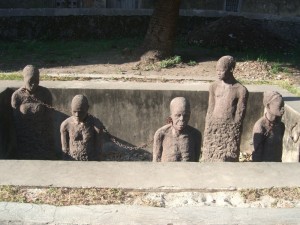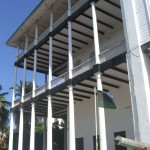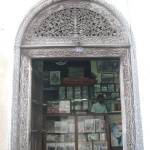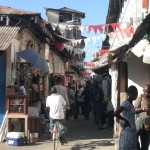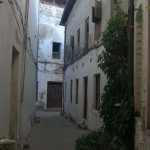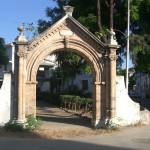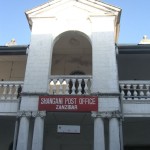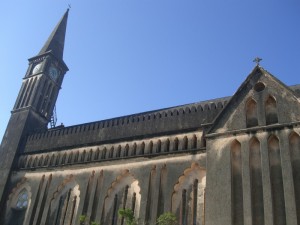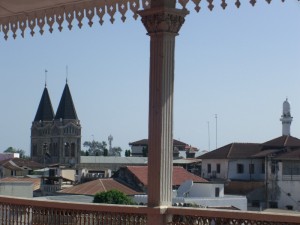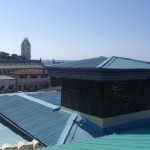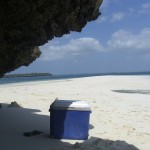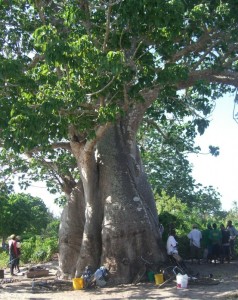I began my East Africa trip on February 3 upon completion of my 28-day stay in Ethiopia. I had a painful and bloody experience in Zanzibar but was thrilled to reach Mt Meru (4566m), Tanzania’s second highest peak before returning to Hong Kong.
Tanzania
Area: 886,039 square kilometres (Africa’ highest peak, Mt Kilimanjaro (5898m) is located in Tanzania)
Population: over 41 million (2010 est)
GDP: US$21.37 billion (2009 est); GDP per capita: US$503 (2009 est); GDP per capita (ppp): US$1500 (2010 est)
Part 1 : Zanzibar (February 3-6)
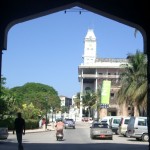 Zanzibar archipelago comprises numerous islands with two main ones, namely Unguja (informally referred to as Zanzibar) and Pemba. The territory had long been visited by Persian, Arab and Portuguese traders and was controlled by the Omanis in the 18th and 19th century. As many as 50,000 slaves passed through the slave markets in Zanzibar in the mid 19th century. Britain established a protectorate in 1890 and Zanzibar became an independent sultanate in 1963. In April 1964, it joined Tanganyika to form a new republic which was renamed Tanzania in October 1964.
Zanzibar archipelago comprises numerous islands with two main ones, namely Unguja (informally referred to as Zanzibar) and Pemba. The territory had long been visited by Persian, Arab and Portuguese traders and was controlled by the Omanis in the 18th and 19th century. As many as 50,000 slaves passed through the slave markets in Zanzibar in the mid 19th century. Britain established a protectorate in 1890 and Zanzibar became an independent sultanate in 1963. In April 1964, it joined Tanganyika to form a new republic which was renamed Tanzania in October 1964.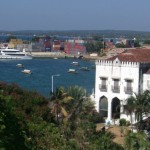
Zanzibar, with an area of 2,643 square kilometres and a population of over 1 million, was once world’s largest producer of cloves and remains famous for its spices. It has been a melting pot of the African, Arab, Persian, Omani, Indian and European cultures. Stone Town, its historic centre, is a World Heritage Site with fascinating and most photogenic architecture – white-washed buildings with Arabic, African and European influence and narrow alleys. There are numerous beautiful sandy beaches and many good spots for diving and snorkeling. It is an ideal place for idling soaking in its unique atmosphere. I intend to chill out before my strenuous treks.
February 3 – Addis Ababa, Ethiopia – Zanzibar, Tanzania (by air)
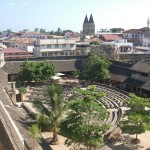 On arrival, a taxi driver took me to see a few guesthouses and hotels in Stone Town. A guesthouse without hot water or sea view asked for US$55. As the Year of the Rabbit would begin the next day, I decided to give myself a treat and stay in a 4-star boutique hotel in a restored old house which has a beautiful rooftop bar with free wifi – an ideal spot for watching sunset.
On arrival, a taxi driver took me to see a few guesthouses and hotels in Stone Town. A guesthouse without hot water or sea view asked for US$55. As the Year of the Rabbit would begin the next day, I decided to give myself a treat and stay in a 4-star boutique hotel in a restored old house which has a beautiful rooftop bar with free wifi – an ideal spot for watching sunset.
In the afternoon, I explored Stone Town on foot. The buildings with its special architectural styles are charming. I stopped outside a photo shop selling heaps of old photos of Stone Town. The shop owner, on knowing that my digital camera was out of order, offered to lend me one of his digital cameras and asked me to come back at 9am the following day. Actually I do not mind renting it for a few days.
I strolled along the waterfront to watch sunset. The evening cooked food bazaar there is popular with both locals and tourists. Though I like local food, I prefer a comfortable sit-down dinner. I had delicious grilled fish and a cold beer in a courtyard near my hotel. I had a great day and slept like a baby in a most comfortable double bed under a mosquito net with air-conditioning! What a luxury especially after my 28 days in Ethiopia as a backpacker!
February 4: Stone Town
I arrived at the photo shop hoping to pick up a camera. The shop owner was nowhere to be seen. Whether I take photos or not is not important. But I dislike people who make promises or offers lightly without any intension to fulfill them. I had a nice tour visiting a spice farm and saw the clover, nutmeg, cinnamon and pepper plants. We visited a cave which used for keeping the slave and stopped in a nice beach for an hour. I had not brought my swimming suit but it was so hot that I went into the water with my clothes on! When I passed by the photo shop in the late afternoon, the shop owner tried to sell his photos without ever mentioning his offer to lend me a camera the day before!
In the late afternoon, I went for a cold beer in the hotel’s rooftop bar and sent e-Chinese New Year greetings to my family and friends with my iPad. I enjoyed watching the sunset and met Peter and Rachael from New Zealand at the bar. Rachael is on an eight-week project with the local government and Peter who is working in Australia, has come to visit his wife. Peter asked me to lend him the iPad’s connector so that he could use his iPad (He left his in Australia). I gladly gave it to him. I picked up my courage and asked Peter whether he could lend me one of their cameras in order to take photos of this dream island.
Peter arrived early in the morning and handed me his camera. I am moved especially after my bad experience with the photo shop keeper. I had a snorkeling trip that morning. There were only two tourists on the boat (myself and a French diver). I put on a short-sleeved diving suit and snorkeled twice, each lasting about 40 minutes. But to my horror, I discovered that the back of both legs (where they were not covered) were swollen and as red as a lobster and went to the diving shop for advice. The owner suspected that I might have been bitten by jelly fish and poured some vinegar on my legs. It did not help much and I walked in pain for the rest of the day.
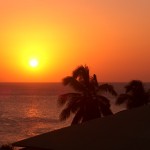 The charm and beauty of this ageless old town are captivating. I forgot the pain and spent a couple of hours strolling along the narrow alleys and visited the Anglican Church where the slave market once stood, the national museum at the palace, the market and some old houses. I also signed up for another eco -boat trip to a remote island the following day (thinking that the pain would go by then!). I watched a beautiful sunset at the bar with Rachael and Peter. To celebrate the Chinese New Year, I gave myself a treat and had dinner at a famous and expensive rooftop restaurant known for its fantastic view. Unfortunately, the food and the atmosphere disappointing do not live up to their reputation. I wish I had joined Peter and Rachael for a dinner by the beach.
The charm and beauty of this ageless old town are captivating. I forgot the pain and spent a couple of hours strolling along the narrow alleys and visited the Anglican Church where the slave market once stood, the national museum at the palace, the market and some old houses. I also signed up for another eco -boat trip to a remote island the following day (thinking that the pain would go by then!). I watched a beautiful sunset at the bar with Rachael and Peter. To celebrate the Chinese New Year, I gave myself a treat and had dinner at a famous and expensive rooftop restaurant known for its fantastic view. Unfortunately, the food and the atmosphere disappointing do not live up to their reputation. I wish I had joined Peter and Rachael for a dinner by the beach.
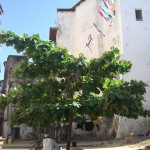 |
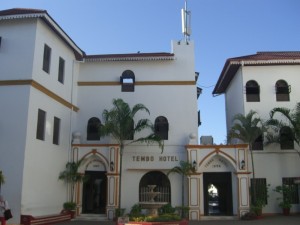 |
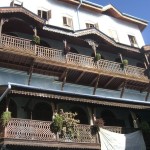 |
My painful day turns into a night of horror. On return to my hotel, I went to the bathroom to wash my feet. As one of the sliding doors of the shower cabin had derailed, I tried to lift and fix it. But all of a sudden, the whole panel of glass broke into thousand pieces and I saw lots of blood coming out of my right-hand wrist. I did not feel any pain though the sight with shattering glass and blood was most frightening. I stayed sober and knew I had to get help without delay. I grabbed a hand towel to cover my brief as I had already taken off my skirt and walked bare-footed over the broken glass to reach the door. I shouted for help once I reached the corridor.
My call was answered immediately and several staff rushed in. Blood was still flowing out of my vein and they were shocked to see my condition and the blood stains everywhere. I asked them for a chair and a bowl of water. I sat down and tried to get pieces of glass off my feet. The waitress at the bar is smart: she realised I was embarrassed and got me my skirt from the bathroom. I asked the staff to take me to a hospital/clinic. Accompanied by the waitress and an English-speaking staff, I was rushed to a hospital.
I have never thought that I would be ending up in a hospital in Zanzibar on the second day of the Chinese New Year. There were many locals in the waiting room and I waited some 40 minutes to see a doctor. I had four stitches on my right hand wrist: it is the first in my life to be stitched. The nurse told me to come back to change the dressing before leaving Zanzibar on February 7. What a day with painful legs and a deep wound on my wrist! I could not sleep comfortably: I could not lie on my back as my legs were burning.
I am an optimistic person always looking things on the positive side. I hope the worst is over and the blood and pain will take away the evil and the bad for the rest of the Year of the Rabbit. In any case, I count myself as lucky as the cut could have been deeper and caused my life!
February 6: A painful day
I joined a Swiss couple on an eco-boat trip. The island is tiny and picturesque with a long sand pit during low tide. There are some trees and curved rocks that provide some shade. Given my condition, I had to seek shelter under the trees and finished reading a fiction which title is ‘Zanzibar’. The Swiss couple also found the sun too strong and we decided to return to the mainland soon after lunch.
On the way back, we saw many local fish men coming in with their catch and gathered under a large boa tree to sell their catch of the day. A very African atmosphere!
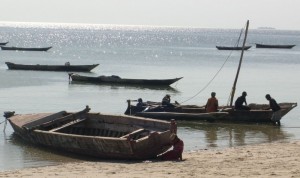 |
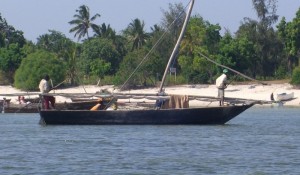 |
That evening, Peter, Rachael and I had dinner in a Chinese restaurant. The owner came from Southern China and his son born in Zanzibar can speak Cantonese with an accent. The restaurant was full with 50-60 Chinese visitors and many tourists. Business is very good because the food is delicious and authentic. What a nice surprise to find genuine Cantonese cooking in Zanzibar! My generous friends paid for the dinner and I fully appreciate their kindness and hope to reciprocate one day.
February 7: Zanzibar – Nairobi, Kenya (by air)
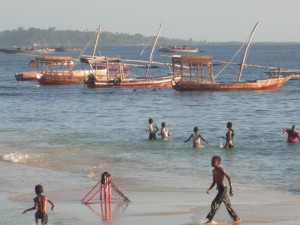 I had the dressing changed at the hospital before leaving for the airport. The nurse told me that there was no infection and I only need to change the dressing in three days’ time. I took a last look at the beautiful islands when the plane was hovering above the archipelago.
I had the dressing changed at the hospital before leaving for the airport. The nurse told me that there was no infection and I only need to change the dressing in three days’ time. I took a last look at the beautiful islands when the plane was hovering above the archipelago.
I shall always remember my painful and bloody sejour in Zanzibar! I feel let down by the shop owner who does not keep his words. It is however a blessing to meet people like Peter and Rachael and to stay in the enchanting and atmospheric Stone Town. The dreadful pain on my sunburn legs and the cut on my wrist are scaring. I would not sue the hotel but I have urged the management to replace the breakable glass shower cabin in all the rooms with non-breakable ones without delay. I have been lucky and have escaped. But another accident can be fatal.
Part 2 : Trekking (February 18-22) (No photos for this part)
February 18: Nairobi – Arusha (by bus)
I left Nairobi by bus in the morning and reached Arusha, the trekking capital of Tanzania around 2:30pm. Upon arrival at the bus stop, I was swarmed by tour operators. A man who is a director of a trekking company followed me to my hotel. He looked honest and I decided to trek with his company and asked him to provide me with a camera. He said ‘ no problem’ right away. We agreed a price for a 4-day trek. As the transfer cost over US$100, I asked whether I could share a car with other trekkers. He called a number in front of me and then said that the Dutch couple who would be doing the same trek with his company would not like to share a car. (I subsequently discover there’s no Dutch couple taking the trek with his company. He should not lie!).
February 19-21 – 3-day Mt Meru trek
I was picked up from my hotel and went to the tour company to meet my guide. Apparently the man who arranged the trek forgot his promise to provide me with a camera. Instead he called a staff who asked for US$20. Though I was annoyed, I agreed and just wanted to have a camera. He took me to his place to get the camera which turns out to be a model using a different type of memory card. I was frustrated as they were wasting my time. I despise people who do not honour their promises. The tour manager and the photo shop owner in Zanzibar behave alike. Also, if the tour operator wants money for the camera (instead of providing it free of charge), he should have told me when I booked the tour and showed me the model. I was angry and told the man that I would not borrow his camera. Hence, I had no photos on this trek.
Mt Meru (4566m), an active stratovolcano, is the second highest peak in Tanzania and the fourth highest in Africa. As trekkers must be accompanied by a Park ranger, I was told to join a party of four young trekkers from Holland. We set off from the Momella Gate after clearing all necessary paper work around 12:30pm and reached the Mariakamba Hut (2514m) around 4pm. The path through the forest with plenty of vegetation is nice and the hike is relatively easy. I am however disappointed to find many jeeps and 4-wheel drive vehicles driving on the same path. The camp has very good facilities including clean beds and toilets. I had a room (with four bunk beds) by myself and a good sleep.
On the second day, we set off accompanied by half a dozen people (the Park ranger, my guide and several guides and cooking staff for the Dutch group). The 3-hour hike to the Saddle Hut (3570m) is not difficult though there are a lot of steps at the beginning. The second camp is well-kept and clean and has fantastic views of the white-top Mt Kili. After lunch, we hiked for an hour to reach little Meru (3801m) which gives a good view of Mt Meru and Mt Kili. The climb also helps preparing trekkers for the hike to Mt Meru. The sunset from the camp is gorgeous with stunning views of the Mt Meru, Mt Kili and all the lakes below.
The hike to Mt Meru exceeds my expectations. The Mt Meru trek, in my view, is shorter but more beautiful and difficult than the Mt Kili trek. We set off at 2am with a full moon on February 21. The soft but brilliant moonlight is much better than headlight. The trek is long with dozens of ups and downs. As I have a knee problem, I do not like steep slopes or rock climbing. But there are a few sections requiring me to crawl or climb using my four limbs! The final section is particular difficult and exhausting. But the magical daybreak, the first sunray, the stunning views of Mt Kili in a distance and my urge to reach the summit propelled me to move on. My young guide looked sick and walked on his own most of the time. I struggled and fell a couple times. But I finally reached the summit around 7:30am after five hours’ strenuous walk. My Dutch friends who already had their cup of hot tea and biscuits, took a couple of pictures for me next to the sign ‘Socialist Peak 4,562.13M’. (I have not been able to contact them through email and have no photos of this trek at all). The walk back to the Saddle Hut takes less than three hours. The scenery is stunning and difficult to describe with words. On my way down, I kept looking back at the peak and the long, steep and rocky path. I cannot believe I have reached the summit!
After a nice brunch, we descended to the Mariakamba Hut and the Ranger arranged a jeep to take us back to the Momella Gate. Steps are more tiring for the legs than gentle slopes. To lessen the pressure on my knees, I had to put both feet on each step thus moving at a snail pace. In any case, I made it and received a certificate for reaching the peak. A nice souvenir!
After spending a leisure morning in Arusha on February 22, I took a minibus which dropped me off at the Nairobi airport at 8pm. I had a safe journey and reached home on February 23 ending my 70-day journey.
Remarks
This trip is not long but most painful. I am grateful that I am alive despite the accidental suicidal cut on my wrist. I have been taking more antibiotics and applying various creams on the wound since returning to Hong Kong as there are still signs of infection. I also have pains in my feet from time to time. To play safe, I have had both my wrist and feet x-rayed to make sure there is no glass left inside. I hope the hotel management has taken my advice and replaced the breakable glass in the shower cabin. No one knows when another accident will happen.
I am very pleased to be able to reach Mt Meru despite my knee problem. The trek leading to the summit is spectacular with stunning views of the whole region including a Kilimanjaro in white. It’s astonishing that I could walk after 11 hours’ walk without serious post-trek pains. Though I have abandoned my Mt Kili trek plan this time owing to the accident in Zanzibar, I hope to reach its summit one day.
During my brief stay in Tanzania, I have come across so people, some are kind and genuine and others unreliable and dishonest. I am lucky to meet Peter and Rachael and hope to see them somewhere again. The shop owner in Zanzibar and the tour operator in Arusha who have made empty promises, have let me down. I hope they won’t do this again to others in future. My young trekking guide is not professional: he does not have the personality as a trekking guide or the passion for trekking. Trekking tourism is an income earner for both Kenya and Tanzania and I believe the trekking companies can learn a lot from their counterparts in Nepal.


